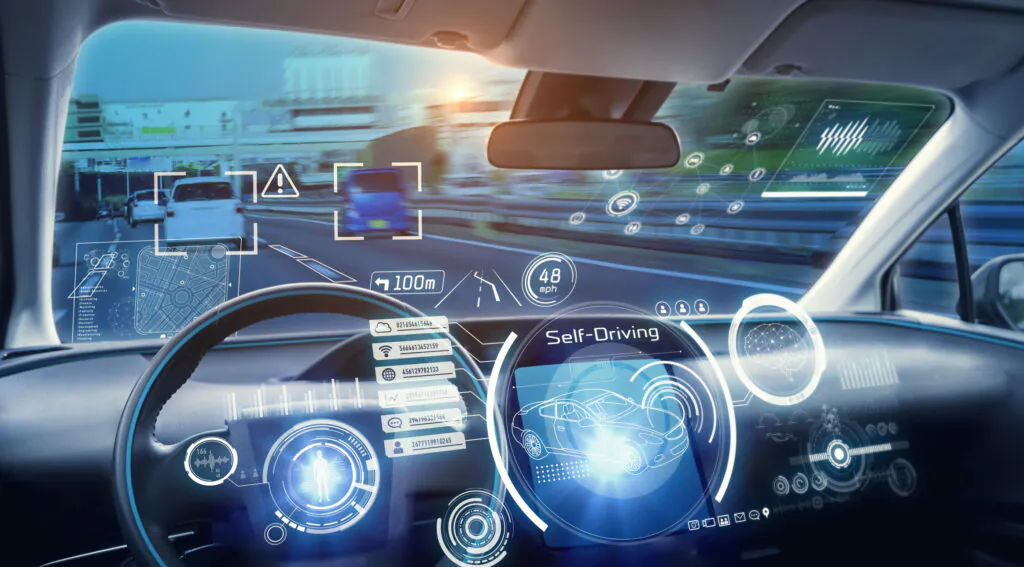Author: Sudeshna Ghosh
Introduction
The global automotive industry is rapidly transforming with the growing innovations in automobile engineering and increased investment in research and development by automobile manufacturers. Trends in the automotive industry like connected cars, electric vehicles, and autonomous or self-driving automobiles are driving growth in terms of revenue and inventions. The automotive industry is one of the important industries in the world where automobile manufacturers undertake a wide range of activities right from designing vehicles to selling them in the market. The connected car, one of the recent developments in the auto industry, has the potential to disrupt the automobile market with a high level of digital infiltration, which will bring a wave of change across the global market.
Connected cars are touted as the “next big thing” in the automotive industry and will soon replace the traditional mode of transportation for businesses and consumers alike. In simple words, a connected car can be explained as a motor vehicle that leverages mobile technology and the internet to operate and control key functions with the help of a smartphone, watch, tablet, or desktop. These automatic cars work on the principle of IoT and are expected to offer new services to customers, which will help revamp the driver-car relationship soon.
What Does ‘Connected Car’ Mean for the Automotive Industry?
A “connected car” refers to a vehicle equipped with internet connectivity that allows it to communicate both with external systems and other vehicles, enhancing the driving experience through features like real-time navigation, safety alerts, and entertainment services. This technology is transforming the automotive industry by enabling data exchange that improves vehicle performance, supports autonomous driving capabilities, and fosters a more integrated transportation ecosystem.
Connected Cars and Their Drivers
Automotive manufacturers are increasingly adopting digital technologies across their automobile designs. Connected cars offer a wide array of technology and IoT-enabled features such as real-time traffic data, smartphone-vehicle synchronization, and driving assistance; thereby, changing the customer’s definition and usage of a motor vehicle. Today, technology-led automobile engineering companies leverage artificial intelligence and telematics to deliver an exclusive customer driving experience. Connected cars offer safety, increased efficiency, better value proposition, and personalized customer experience, thereby changing the operations and functioning of the global automotive industry.
How do Connected Cars Work?
Connected cars work by integrating various technologies that allow them to communicate with their surroundings and other systems. Here’s a brief overview of how connected cars function:
Internet Connectivity
Connected cars are equipped with internet connectivity, either through embedded systems built into the vehicle or tethered systems that rely on external devices like smartphones. This internet access enables a wide range of features and services.
Communication with Other Vehicles
Connected cars use wireless communication technologies like dedicated short-range communications (DSRC) to exchange data with vehicles (V2V) and infrastructure (V2I). This allows for collision avoidance, and coordination in autonomous driving.
Sensors and Data Collection
Connected cars are equipped with numerous sensors that collect data about the vehicle's performance, driver behavior, and surrounding environment. This data can be used for diagnostics, predictive maintenance, and enhancing the driving experience.
Remote Access and Control
Many connected car features allow drivers to remotely access and control certain vehicle functions using mobile apps or web portals. This includes features like remote start, locking/unlocking doors, and monitoring vehicle health.
Advanced Driver Assistance Systems (ADAS)
Connected car works in tandem with ADAS to provide features like lane departure warnings, and automatic emergency braking. These systems rely on sensors, cameras, and communication with other vehicles and infrastructure to enhance safety.
Infotainment and Connectivity Services
Connected cars offer a range of infotainment features, such as music streaming, internet browsing, and access to various apps. They also provide connectivity services like emergency assistance, concierge services, and vehicle tracking.
The combination of internet connectivity, wireless communication, sensors, and advanced software enables connected cars to offer enhanced safety, convenience, and a more personalized driving experience. As technology continues to evolve, connected cars are poised to play a significant role in the future of transportation.
How do Connected Cars Communicate?
Connected cars communicate through various technologies that enable them to interact with their environment and other entities. Here are the primary communication methods:
Vehicle-to-Vehicle (V2V)
This technology allows cars to exchange information about speed, position, and direction with each other, enhancing safety by helping to prevent collisions and improve traffic flow.
Vehicle-to-Infrastructure (V2I)
Connected cars communicate with traffic infrastructure like traffic lights and road signs to receive real-time information about traffic conditions, roadwork, and safety alerts, aiding in navigation and decision-making.
Vehicle-to-Cloud (V2C)
This connection enables vehicles to communicate with cloud services, allowing for data exchange related to diagnostics, traffic updates, and other applications that enhance the driving experience.
Vehicle-to-Pedestrian (V2P)
This technology allows vehicles to communicate with pedestrians and cyclists, providing warnings to enhance safety and prevent accidents.
Vehicle-to-Device (V2D)
Connected cars can interact with personal devices, such as smartphones, via Bluetooth or Wi-Fi, enabling features like remote access and control of vehicle functions.
Vehicle-to-Grid (V2G)
For electric vehicles, this technology allows communication with the power grid, enabling two-way energy flow for charging and energy management.
These communication methods form part of the broader Vehicle-to-Everything (V2X) ecosystem, which enhances safety, efficiency, and convenience in modern transportation.
What’s Driving the Connected Cars Market, You Ask? Here’s What.
The market space for connected cars will be driven by these factors, across the globe. However, the automotive industry will face a few roadblocks before achieving complete digital transformation. The challenges of the connected car market include data threats, platform incompatibility, and questions over its customer safety quotient. But for now, connected cars are the next big thing in the automotive industry and it is here to stay.
Revenue Opportunities in Connected Cars

Connected cars are opening up significant revenue opportunities for the automotive industry by leveraging advanced connectivity features and data-driven services. Here are the key points regarding these opportunities:
- Subscription-Based Services: Connected cars enable manufacturers to offer subscription models for various services, such as navigation, entertainment, and advanced safety features, which can redefine the driving experience and create ongoing revenue streams.
- Data Monetization: The vast amount of data generated by connected vehicles can be monetized, allowing manufacturers and service providers to create tailored offerings, improve customer engagement, and enhance operational efficiencies, potentially expanding automotive revenue pools by about 30% by 2030.
- Fleet Management Solutions: For commercial fleet operators, connected cars simplify management through real-time tracking and analytics, optimizing routes and improving operational efficiency, which can significantly enhance profitability.
- Enhanced Customer Experience: Connected vehicles can provide personalized services, such as concierge features that adapt to driver preferences, thereby increasing customer satisfaction and loyalty, which can translate into higher sales and service revenues.
- Integration with Smart Cities: Collaboration with smart city initiatives can lead to improved traffic management and infrastructure utilization, creating additional revenue opportunities through partnerships and innovative service offerings.
- Future Projections: By 2030, it is estimated that the annual revenue potential from connected cars could reach up to $1.5 trillion, driven by both individual consumer subscriptions and commercial fleet services, highlighting the transformative impact of connectivity on the automotive industry.
These developments illustrate how connected cars are not just enhancing the driving experience but also creating substantial financial opportunities for various stakeholders in the automotive ecosystem.
Real-World Examples of Connected Cars
Here are real-world examples of connected cars that illustrate the advancements and applications of automotive connectivity:
| Car Model | Manufacturer | Key Features |
| Tesla Model 3 | Tesla | Offers over-the-air software updates, Autopilot capabilities for semi-autonomous driving, and a comprehensive infotainment system with internet access. |
| Audi A8 | Audi | Features a connected infotainment system with real-time traffic updates, V2V communication for enhanced safety, and remote vehicle management through a mobile app. |
| BMW 7 Series | BMW | It includes BMW ConnectedDrive, which provides real-time navigation, remote services, and integration with smart home devices. |
| Ford F-150 | Ford | Equipped with FordPass Connect, allowing remote start, vehicle health monitoring, and Wi-Fi hotspot capabilities. |
| Mercedes-Benz S-Class | Mercedes-Benz | Offers MBUX infotainment system with voice control, real-time traffic information, and V2I communication for improved navigation. |
| Toyota Camry | Toyota | Features Toyota’s Safety Connect for emergency assistance, remote access via the Toyota app, and real-time traffic updates. |
| General Motors (OnStar) | General Motors | Provides connected services like emergency response, vehicle diagnostics, and navigation assistance across various GM models. |
These examples demonstrate how connected cars are enhancing safety, convenience, and the overall driving experience through advanced technology and connectivity features.
How Can Infiniti Research Help You?
Infiniti Research offers comprehensive support for businesses in the automotive industry, particularly in the realm of connected cars. Here’s how they can assist:
Market Insights and Trends
Infiniti Research provides in-depth analysis of current trends in the connected car sector, including advancements in technology such as vehicle-to-everything (V2X) communication and the integration of the Internet of Things (IoT). This knowledge helps automotive companies stay ahead of the curve and adapt to evolving consumer demands and technological advancements.
Challenges Identification
We identify key challenges faced by connected car companies, such as ensuring real-time connectivity and addressing consumer skepticism. By understanding these challenges, businesses can develop strategies to enhance user experience and build trust with their customers.
Data-Driven Decision Making
Infiniti Research emphasizes the importance of data-driven tools for optimizing pricing and market strategies. We conduct market surveys and interviews to gather insights that inform pricing decisions, allowing automotive companies to align their pricing structures with customer expectations and market realities.
Pricing Strategy Development
Through our expertise in price analysis, we help automotive clients develop dynamic pricing strategies that minimize unnecessary discounts and incentives. This approach not only improves profit margins but also enhances overall pricing transparency and customer satisfaction.
Business Impact
By leveraging our services, automotive companies can expect significant improvements in their operational efficiency and profitability. For instance, clients have reported up to a 70% increase in sales margins through optimized pricing and better market positioning.
Overall, Infiniti Research equips automotive businesses with the insights and strategies necessary to thrive in the competitive landscape of connected cars, driving innovation and enhancing consumer engagement.
Conclusion
Connected Cars are revolutionizing the automotive industry by integrating Vehicle to Vehicle (V2V), Vehicle to Infrastructure (V2I), and Vehicle to Everything (V2X) technologies. These advancements, coupled with Advanced Driver Assistance Systems (ADAS), enhance safety through features like Lane Keeping Assistance, Adaptive Cruise Control, and Collision Avoidance. Leveraging IoT (Internet of Things) and Telematics, connected cars utilize Real-time Data and Predictive Maintenance for optimal performance. Cloud Connectivity supports Advanced Safety Technologies and unlocks new Revenue Opportunities. Together, these innovations are driving the future of mobility, making roads safer and more efficient.


